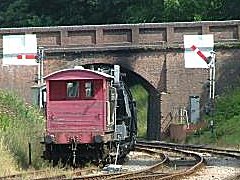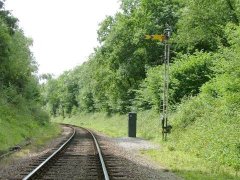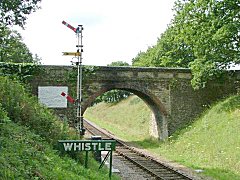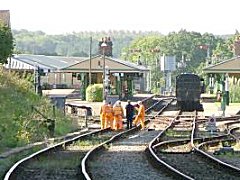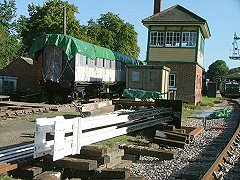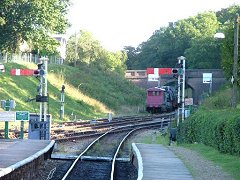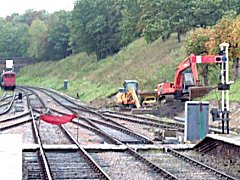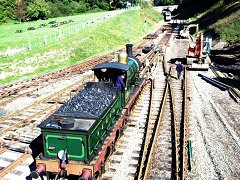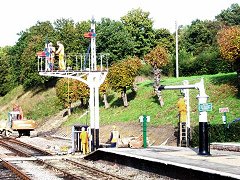

|


|

|
|
Signalling & Telecoms: - Signals - Signal Boxes - Diagrams for East Grinstead - Kingscote - Horsted Keynes - Sheffield Park Bell Codes - Staff Instruments - Key-Token Instruments - Walkers Train Describers - Horsted Keynes Re-signalling 

Horsted Keynes Re-Signalling
|
|||||||||||||||||||||||||||||||||||||||
The north end on 4th October showing the ground frame point beside the yellow dumper truck and the old Up Starting Signal. |
Nº65 shunting in connection with the engineering works to the north of the station shows that by 7th October much old track had been removed in readiness for relaying. |
The afternoon of Thursday, 7th October with the S & T personnel dressing the signals 36A & 36B to control the passage of trains to either the reversible loop (former up line) or the main reversible line (former down line). |
Photographs: Robert Hayward
Such progress over the week would not have been possible without the generous co-operation of John Millam and of the assistance of several shunters and the footplate crews of the engineering trains.
Text from Robert Hayward of the Alf Brown Gang.
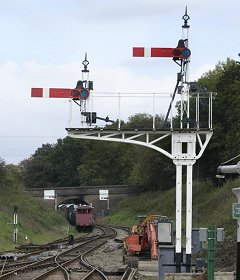 |
Left: The new signal complete with arms.
Right: As the signal is not yet connected to the Signalbox, the Signalman displays a green flag to allow an up service for Kingscote to depart on 9 October. Photographs: Paul Pettitt |
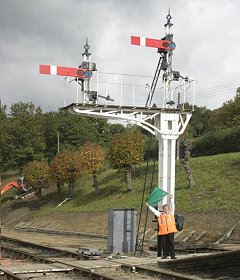 |
Nº35 signal, 4 Road Up Starter, which was slotted with the Signalbox and the Ground Frame, has been altered as a result of the removal of the Ground Frame. The post and some of the fittings have been repainted by Alan Dengate, with a fresh spectacle plate being prepared by Dave Phillips.
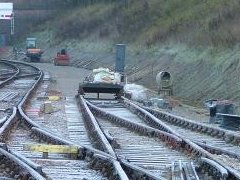
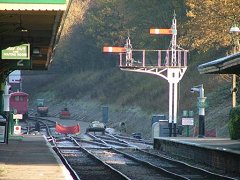

The new point in situ, with the trackbed prepared beyond. |
The work site at the north end of the station. |
Visiting locomotive Leander leaving platform three for Kingscote, 14 November 2004. |
Photographs: Chris Majer
Relaying the track north of the station overran the time allocated and was still ongoing mid-November. The new pointwork is in position and the track bed prepared, but the track and S&T cabling remained to be completed. Another 6 panels of track have been laid along the Ardingly branch and work there is pushing ahead to reach the point where the formation presently ends.
Text from Chris Majer
Following completion of the engineering works, the new points (19B) at the North end of 3 and 4 roads and replacing those formerly operated from the Ground Frame, are now operated from the signal box, together with 19A, which form the South end of the crossover from 3 to 2 road and are located immediately North of the platform end of 3 road. A new Ground Position Light Signal (18) has been provided in the rear of the points on the cess side of the line and applies for moves to Nº3 or 4 road. The signal also acts as a preceding shunt for running moves from the Down Inner Home signal (running dummy) and therefore it must be cleared before the Down Inner Home can be cleared.
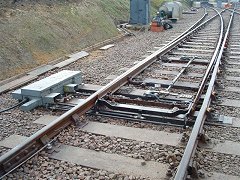
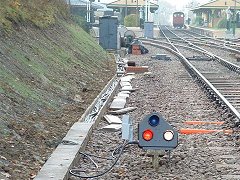
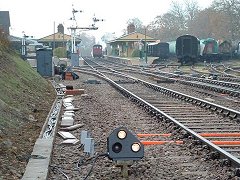
The new Nº19B point. |
Position Light Signal Nº18 showing the "On" aspect. |
Position Light Signal Nº18 showing the "Off" aspect. |
Photographs: Adrian Lee
The Down Inner Home signal (4) now applies as before, to Nº3 road, together with a new route to Nº4 road. The route indicator displays '3' or '4' as appropriate. If the route is set into Nº4 road but not back out towards the single line to Sheffield park, then the Down Inner Home signal will not clear immediately but will be Approach Controlled and only come 'Off' when the approaching Down train occupies the track circuit immediately before the signal. This effectively enforces an automatic application of Rule 39A as the following Starting signal (7) will be 'On'
If the route is set through Nº4 road and out at the South, or indeed through Nº3 Road the signal will clear as soon as the controlling switch is operated. It is then down to the Signalman to apply Rule 39A himself if the appropriate Down Starting Signal is on. The previous method of working Up trains through Nº4 road and Down through Nº3 road was reversed with effect from Sunday 28 November.
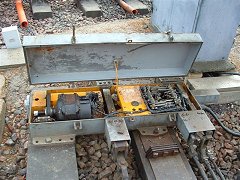
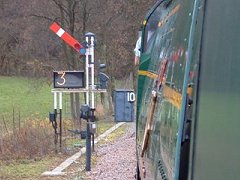
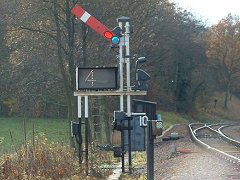
Inside a Point Machine. |
Down Inner Home Signal Off for Nº3 Road. |
Down Inner Home Signal Off for Nº4 Road. |
Photographs: Adrian Lee
Text from Adrian Lee
First Quarter 2005
A new shunt sgnal mounted on a post (to improve driver
visibility), is to be commissioned at the north end of platform Nº2. This
will allow signalled shunt moves up to Nº29 signal (Up Loop Advance
Starter).
Work on the Ardingly Spur is progressing with the track laid up to the edge
of the demolished Sheriff Mill viaduct, and the undergrowth in the area has
been cleared. Permission has been given to dig out the clay and sandstone spoil
at the south end of Imberhorne tip and once further permission has been granted
for the planned in-fill, works trains are planned to move the spoil to the
Ardingly Spur.
Anyone wondering what has happened to the 3 lever groundframe removed from the
London end of 3 & 4 roads can see it sitting behind Horsted Keynes
Signalbox awaiting its next assignment!
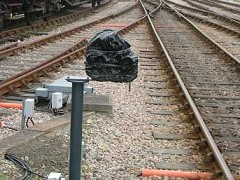
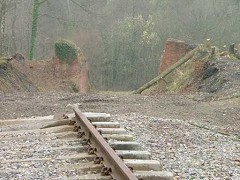
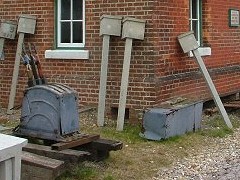
The north end of platform 2 on 20 March 2005, showing the new position light shunt signal under wraps until commissioned. This will eventually be replaced with a semaphore signal. |
The far end of the Ardingly Spur, showing the track laid as far as it is presently possible to go. |
The retired ground frame from the north end of number 3 & 4 roads, sitting outside the Signalbox. |
Text and Photographs: Chris Majer
Second Quarter 2005
The first quarter picture of the Nº2 Platform Up Shunt
has changed already with the bracket removed to improve clearances. Reading
back into the station is the new Nº13 shunt, at present bagged out of use,
that will also be a preceding shunt, reading into platforms 2 and 3,
initially.
When the changes are commissioned for the spoil trains from Imberhorne Lane
bridge to Ardingly Branch, it will be possible to signal Down trains into
platforms 2 and 3 via the Loop line. Similarly Up trains will be able to
leave platform 3 going via the Up Loop or Up Main.
However initially only goods traffic or shunt moves will be able to depart
from platform 2 in the Up direction, signalled via the shunt signal up to the
Up Loop First Advance (Nº29). Work on the Up Second Advance signal
(Nº28) is at the design stage at present.
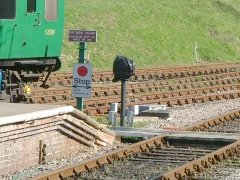
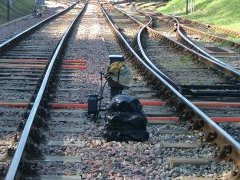
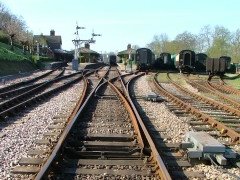
The platform 2 up shunt signal with the bracket shown in the first quarter's photo now removed. |
The new Nº13 down shunt signal, presently bagged whilst awaiting commissioning. |
Looking back into the station just south of shunt signal Nº13 at point 17, from the up loop to numbers 2 or 3 road, then point 16, from 2 road to numbers 1 road or continuing down 2 road. |
Text and Photographs: Chris Majer
Sunday, 22 May saw the S&T, assisted by the P Way gang, working on the installation of the signal motor and arm of the 2nd Up Advanced Starting Signal.
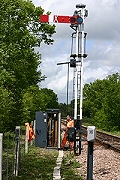
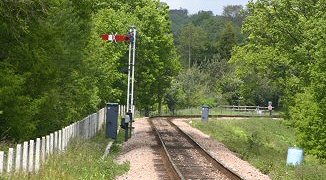
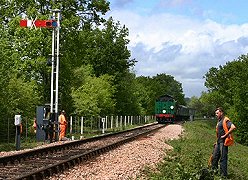
Photographs: Jon Bowers
There has been much activity wiring-up and testing the
alterations ready for the running of the spoil trains from Imberhorne tip, with
the introduction of the new arrangements at the north end of the station due to
be commissioned today, 3 June.
Trains will be able to be signalled over the Loop as well as the Main route, in
either direction and with all points controlled from the Signalbox and, for the
first time since the resignalling project started, it will be possible to
signal trains to and from platform 2 at the north end. The final bracket
signal, to be positioned at the end of platform 1/2, is presently under
construction.
A new Up 2nd Advance Starter Signal (Nº28) is in position and ready
for commissioning on 3 June, as is a new solenoid shunt signal (Nº2)
positioned at the Down Inner Home for shunt moves towards all
platforms and the Up Sidings. It will be possible to signal trains
into the Up Sidings but the signals within the siding area are at
present mechanical shunts fixed "on" and are awaiting the
commissioning of the lever frame.
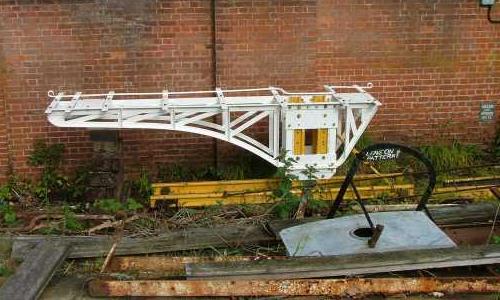
The final bracket signal under construction.
Text and Photograph: Chris Majer
Saturday, 4 June, was the first whole day of operating with the new signals following their commissioning of the previous day. We now have a very flexible layout with just about every possible move being accommodated. But when everything is back on the lever frame, the signalman will have to work hard for his pay (£0 per hour) on Special Events Days!
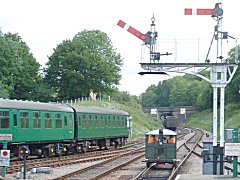
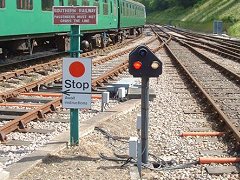
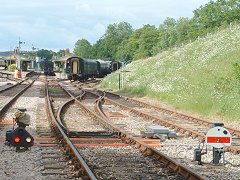
On 4 June 2005, P/Way trolley departs under the authority of signal 36A via 19A and 17 Points to take the Loop to Signal 29, Points 5 and thence to Kingscote. |
Stop Board applying to No 1 Platform Road and Signal 31 (showing 'on') applying to Nº2 Platform Road. Although Nº 31 Signal is designated 'From Nº2 Road Shunt North', it carries exactly the same level of controls as the Up Starters from Nos 3 & 4 Platforms and can, if required, be used for passenger trains (as with Nº8 southwards from Platform 2). |
Position Light Signal 13 (From Loop Shunt) and Signal 12 - Up Siding to Up Yard (Fixed at Danger). |
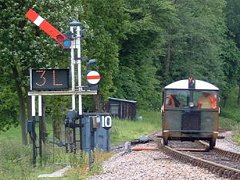
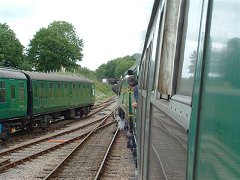
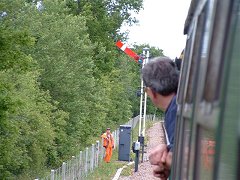
P/Way Trolley returns to HK with Signal 4 cleared for Nº3 Platform Road via the Loop. Shunt Signal 2, a floodlit solenoid shunt, can be seen to the right. When cleared for a shunt move, the route indicator will only show 'T' or 'L', depending on the lie of Points 5, as being a shunt move, Signal 2 only authorises moves as far as the line is clear, towards the next (shunt) signal, either Nº13 or Nº18. |
Blackmoor Vale (21C123) departs for Kingscote and takes the 11.00 ex-Sheffield Park over the crossover from Nº3 Platform Road and up the Loop, towards Signal 29 and thence via Points 5 to the Section Signal, 28 (Up Second Advanced Starting) and thence on to Kingscote. |
Blackmoor Vale takes the 11.00 ex-Sheffield Park past Signal 28, watched by Ray Burgess, of the S & T Dept. |
Text and Photographs: Adrian Lee
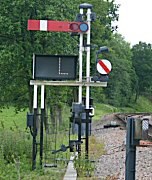
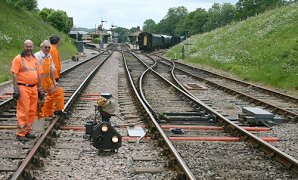

Above left: Signal Nº2 is 'off' for a non-passenger movement via the loop line, ultimate destination Nº2 road. At the time Nº2 platform road was occupied, hence the shunt signal. Had the route been clear to the next running signal (Nº2 road down starter) then the arm (Nº4) would have been 'off' and the route indicator would have displayed the route (2), as in the photo below. Above middle: Signal 13 shown 'off'. |
The buffer stops at the end of the Ardingly spur were installed on 5 June. |
|
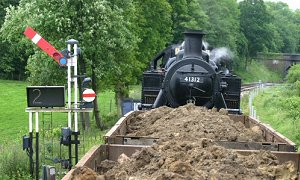 The first spoil train
on 6 June passes Signal Nº4, showing the road is clear into platform 2. It
is unnecessary to show the 'L' in this situation as you cannot access
Nº2 (or Nº1) road from the main route.
The first spoil train
on 6 June passes Signal Nº4, showing the road is clear into platform 2. It
is unnecessary to show the 'L' in this situation as you cannot access
Nº2 (or Nº1) road from the main route.
These four photographs: Jon Bowers
Third Quarter 2005
Progress continues with the construction of the new bracket
post signal to be positioned at the London end of platforms 1 & 2. This
will support the new Up Platform Starters and replace the existing shunt signal
Nº31.
The old Ground Frame from north of platforms 3 & 4, now superseded by
Nº19 points, is to be pressed into service at Kingscote to control the
entry and exit from the Engineer's siding (East Grinstead branch). The
Ground Frame is about to be refurbished and relocked to control the trap points
and signal.
The clay and sandstone spoil from Imberhorn tip (south end) is now filling up
the void on the Ardingly branch and further panels of track have already been
laid over it. Please note that there is no access to the work-site
without authority.
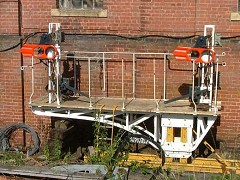
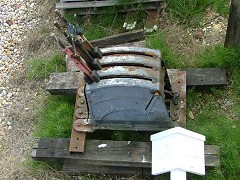

The new bracket signal under construction. |
The groundframe that is being refurbished for use at Kingscote. |
As far west as you can go! The present end of the Ardingly line. |
Text and Photographs: Chris Majer
Fourth Quarter 2005
The bracket signal gantry has been installed at the end of
platform 1 and 2 and work proceeds with fitting it out with a smoke deflector
and signal fittings.
The Imberhorne spoil continues to find its way to the Ardingly Branch and the
siding can now clearly be seen from the road. Unfortunately the recent wet
weather has made the clay difficult to work with and the sandstone is turning
to slurry. As a consequence progress is slow at present.
As a footnote to the new life of the Horsted Ground Frame, this has now been
installed at Kingscote controlling the trap points at the exit of the East
Grinstead Engineers Siding. The protecting shunt signal is oil lit hence
Paraffin Pete has been re-employed!
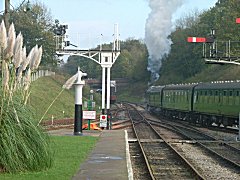
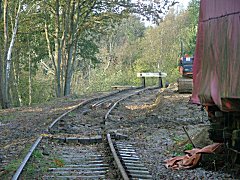
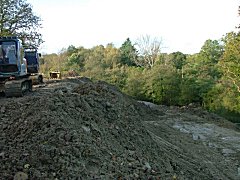
The new bracket signal gantry. |
The Ardingly siding. |
A mountain of mud! |
Text and Photographs: Chris Majer
When a spoil train arrives at Kingscote the engine has to run round so that the train may be propelled up the Engineer's Siding. The Token for the Siding will be handed to the driver by the Signalman who will give the Driver permission to proceed onto the Siding. The Guard (or other authorised person) will be authorised to open the gate once the train is clear of the run-round points, using the Token (that will have been handed to him by the Driver) to unlock and set the ground frame and the signal for the train to proceed. Once the train is clear of the Down Stop Board the Guard will re-set the ground frame, close the gate and telephone the Signalman to tell him this has been done. He will then hand the token back to the Driver who may only then proceed to the tip. When returning, the train must stop at the Down Stop Board and the Guard or other authorised person must telephone the Signalbox for permission to enter the station. Once that has been given he will set the Ground Frame and open the gate. Having allowed the train to proceed towards the Main Platform road he will then reset the Ground Frame, close and lock the gate and telephone the signalman to advise him this has been done. The Token will be returned to the Signalman by the Driver as the train departs south.
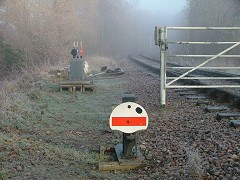
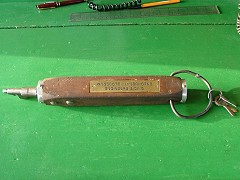
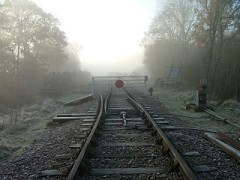
The Up Signal, Gate and Ground Frame at Kingscote. This is an oil lit signal. |
The Token that allows access to the Siding. |
The exit from the Siding. |
Photographs: Chris Majer


Return to BRPS Home Page, to the Timetable or to Special Events
Signalling & Telecoms: - Signals - Signal Boxes - Diagrams for East Grinstead - Kingscote - Horsted Keynes - Sheffield Park
Bell Codes - Staff Instruments - Key-Token Instruments - Walkers Train Describers - Horsted Keynes Re-signalling
Visitor Info. - Museum - Trust - Catering - Contacts - What's New - Projects - Locos - Carriages & Wagons - Signals - History - Other - Links - Search - FAQ
Why not become a BRPS Member? - Get more involved as a Volunteer
Content last updated 11 September 2006 by Peter Richards.
Last updated by Richard Salmon, 14 April 2022
© Copyright BRPS. Privacy Policy
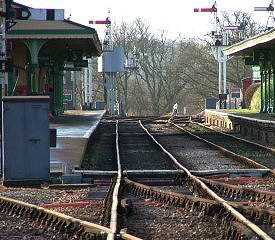
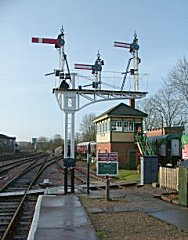
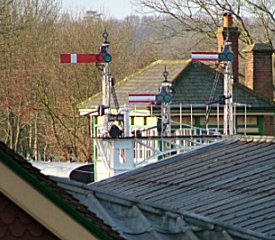
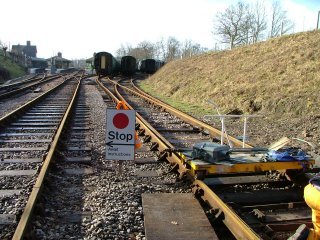 Work is continuing at the north end of the station with the fitting of
Westinghouse type 63 point machines to the Up yard entrance and detection to
the first set of handpoints. Much of the work is awaiting the track renewals at
the north end of Nº3 & 4 roads which will require the advance starter
to be moved, leading to the need to commission the Down outer home to get the
required clearances.
Work is continuing at the north end of the station with the fitting of
Westinghouse type 63 point machines to the Up yard entrance and detection to
the first set of handpoints. Much of the work is awaiting the track renewals at
the north end of Nº3 & 4 roads which will require the advance starter
to be moved, leading to the need to commission the Down outer home to get the
required clearances.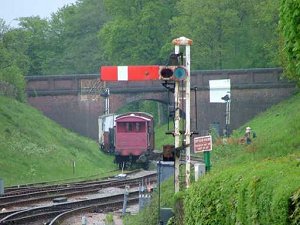 The new Up Advance Starters
(29 and 34) have been fitted with their mechanical fittings and signal
machines. As can be seen in the photograph on the left, the new Nº34
signal has had a white background painted on the bridge to improve the
visibility of the signal arm. This signal will not be commissioned until the
Down Outer Home is ready to ensure adequate overlap separation.
The new Up Advance Starters
(29 and 34) have been fitted with their mechanical fittings and signal
machines. As can be seen in the photograph on the left, the new Nº34
signal has had a white background painted on the bridge to improve the
visibility of the signal arm. This signal will not be commissioned until the
Down Outer Home is ready to ensure adequate overlap separation.